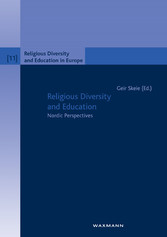Suchen und Finden
Service
Contents
6
Introduction
8
Dimensions of religious diversity
8
Diversity and religious education research
9
International perspectives
10
References
10
Is Diversity Changing Religious Education?
12
Introduction
12
The United Nations and UNESCO
12
European Union (EU) and European Commission (EC)
14
Council of Europe (CoE)
15
The Organization for Security and Co-operation in Europe ( OSCE)
19
Religious Education in Europe: the Present Picture
21
Religious Discourse in the Public Sphere
22
Pedagogical Approaches
23
Conclusion
26
References
26
Encounters in Diversity: Some Suggestions for a Dialogical Religious Education
30
Ouverture
30
The Context: The Place of Religion in Education
30
The Option: A Mutual Learning Process
32
Critical Questions
35
Religion and Experience
36
Formation, Experience and Dialogue
38
Post-Ludium
41
References
42
Unintended Learning in Religious Education
44
Abstract
44
Introduction
44
Reconstruction of Life Understanding – Central Knowledge in RE
46
“Lived” Life Understanding among Teenagers
47
Potential Contributions in a Discursive Practice of Adjustment and Competition
48
Actual Contributions – Results of the Textbook Study
50
Conclusions
53
References
54
Diversity, Values and Religious Education Seen Through Gender – in Relation to a Swedish School Context
56
Abstract
56
Curriculum Changes and a Changing Swedish Society
56
Conceptual and Theoretical Framework
57
Diversity in Feminist Theory
59
Values in a Multicultural Society
61
Religious and Values Education in Sweden
63
A Timely Religious and Values Education
64
Conclusion
66
References
67
Education of Life Itself
70
Introduction
70
Introduction to Danish and German Lebensphilosophie
71
Philosopher or Theologian?
73
Løgstrup’s Impact on Danish RE
74
Bollnow and die Kraft zu leben
75
Central Common Themes
76
Education of Trust
77
Education of Life Itself, Contemporary RE and Diversity
78
References
81
The Life-World and the Teaching of Religions
84
The Life-World and Religion
84
Husserlian Point of Departure
85
The Life-World Theory as a Shift of Paradigm
86
Proto-Pedagogy of Religious Education
87
Transcendence and Religiosity
87
From Phenomenology to Theories of Teaching and Learning
89
References
91
Mounting an Assault on Complexity: Comparative Research Design in Religious Education
94
Abstract
94
Introduction
94
Comparative Studies: Some Relevant Examples
96
Comparative Religious Studies
98
Comparative and International Education
101
Comparing RE in Public Schools in England and Norway
103
References
105
Digitised Church Archives – a Challenge to Religious Educators
108
Abstract
108
The Digitisation of and Access to Archives in Sweden
108
The QVIZ Project
110
Digital Archive Research during the Learning Processes in Religious Education
112
Summary
116
References
117
“To be Honest and Truthful”
118
Method
118
Theoretical framework
119
Major Trends and Patterns
121
Three Individuals
122
Discussion
128
Conclusion
129
References
130
Intercultural and Religious Sensitivity of Finnish Lutheran 7th to 9th Grade Students
132
Abstract
132
Introduction
132
Theoretical Background
134
Method
136
Results
139
Concluding Remarks
143
References
144
From Novices to Experts
146
Abstract
146
Introduction
146
Religion and Spirituality as the Core Content Knowledge in Religious Education
147
Expertise and Content Knowledge
148
Data and Methods
150
Results
151
The Three Dimensions
153
Concluding Remarks
159
References
160
Sheltered from Plurality
162
Teaching Religion and World Views (RE) in Norwegian Schools
162
The Project and its Research Questions
163
Theoretical Perspectives
164
State Elementary School Pupils: in Polyphonic and Perceptive Dialogue9
170
Pupils’ Dialogues with their Contexts
174
Potential Gains and Losses when Sheltered from Plurality
175
References
180
Hindu Children’s Attitudes to Identity Constructs and Diversity: A Challenge for Norwegian Religious Education ( RE)?
182
Abstract
182
Aims
182
Hindus in Norway
183
Methodology of the Project
184
Dialogues in Regards to Attitudes to other Religions
185
Conclusion
194
References
195
The Aims of Orthodox Religion Teachers
198
Abstract
198
Introduction
198
Method
200
Education Differences in Concepts of the Aims of Religious Education
203
Age Differences in Concepts of the Aims of Religious Education
204
Concluding Remarks
204
References
205
Euro-Arab Dialogue and the Other: Some Critical Comments on Textbook Analyses and Production
210
The Image of the Other
210
Images of Others Found in the Texts Analysed
211
Ethical and Ideological Issues
213
Epilogue
221
References
221
Ethical Dilemmas in Confirmation School Experienced by Finnish Confirmation Schoolteachers
224
Abstract
224
Introduction
224
Responsibility and Care as Expressions of Professional Morality
225
Method and Data Analysis
226
Results
227
Ethical Dilemma: Students with Problems
228
Ethical Dilemma: Problems with Young Confirmed Voluntary Workers
229
Ethical Dilemma: Problems with Colleagues
230
Ethical Dilemma: Problems with Parents and Authorities
231
Ethical Dilemma: Teachers’ Confidentiality
232
Ethical Dilemma: Pedagogy in the Confirmation School
232
Concluding Remarks
233
References
234
The Authors
236
Alle Preise verstehen sich inklusive der gesetzlichen MwSt.










